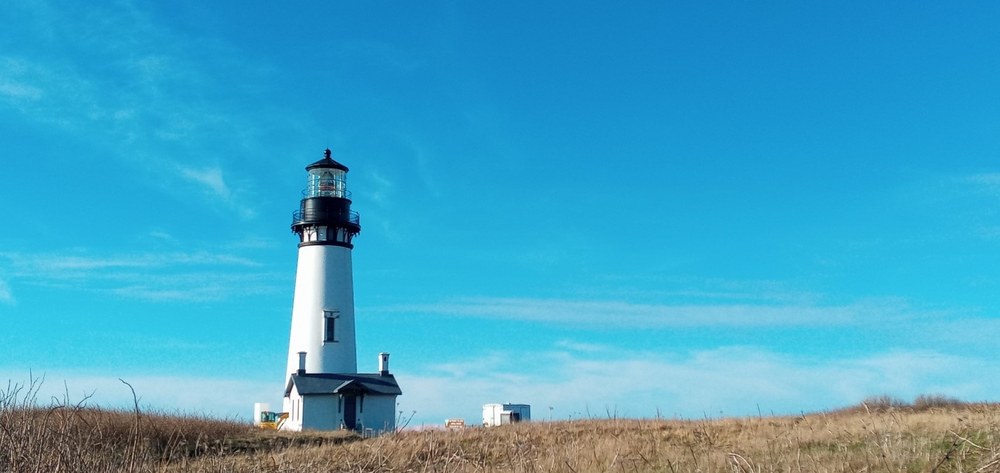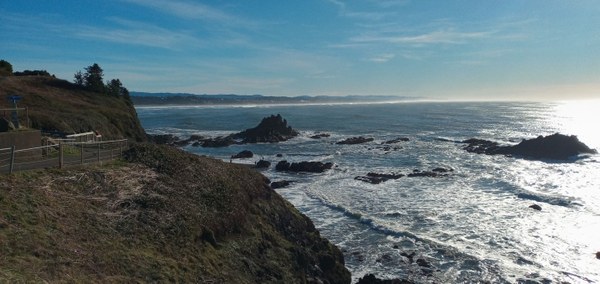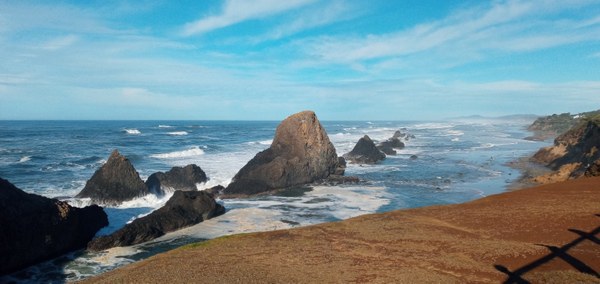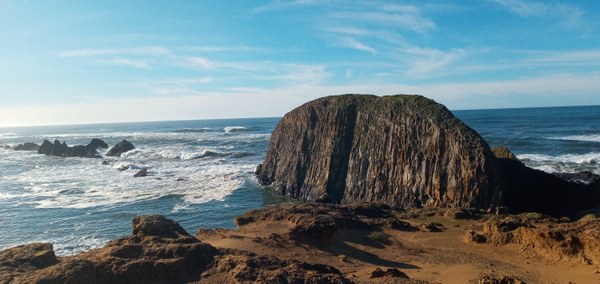
The Oregon coast is known for its stunning geography and charming seaside towns. In a winter trip along the coast I had the joy of visiting two delightful locations on the coast: Yaquina Head Lighthouse and Seal Rock. Read on to learn about these remarkable places, and to find tips so that you might plan your own trip.
Yaquina Head Lighthouse
The lighthouse sits high on a basaltic promontory which some geologist would call an “inverted topography.” The basaltic headlands are at a higher elevation than the surrounding landscape, the softer sedimentary terrain having eroded around them, leaving behind the high headland we see today.
The beach exploration and the tide pools are an awesome adventure for the whole family. Tide pools are better experienced at low tide. Here you have an opportunity to see purple urchins, sea stars, hermit crabs, small fry, and anemones in a wide range of colors.
The views are spectacular and worth stopping to see, as there are many seabirds, including common murres, pigeon guillemots, and oystercatchers. During the winter peregrine falcons are often seen close to the lighthouse resting on Colony Rock. We saw pelicans, cormorants, and red tailed hawks on our trip.
During the spring thousands of seabirds arrive to nest along the rocky cliffs and sea mounts. Baby seals are often found on beaches. Please remember to give wildlife a wide berth. Whatever season you decide to visit, the diversity of habitat from water to land provides the visitor a vast opportunity to see many different plants and animals.
Gray whales are easy to spot, especially during their migration in December and January. You may even spy sea lions and seals resting on the rocky points. Fisherman come from all over to fish for their favorites: bass, perch, lingcod, cabezon, and sea trout.
 Yaquina Head’s Seal Island, from a viewpoint above Cobble Beach. Photo by Regina Robinson.
Yaquina Head’s Seal Island, from a viewpoint above Cobble Beach. Photo by Regina Robinson.
History of Yaquina Head Lighthouse
In 1871 Congress spearheaded $90,000 for the construction of the Yaquina Head Lighthouse, and work began in September of that year.
The Yaquina Head lighthouse was built three miles north of the Yaquina Bay lighthouse. Original orders were for the newer lighthouse to be built on Cape Foulweather, approximately 15 miles to the north. However, the weather and steep cliffs posed a serious challenge and prevented the building at Cape Foulweather; hence, the decision to move the newest lighthouse to Yaquina Head with its easier access points to and from Newport via land and water.
At 93 feet tall, it is one of the tallest lighthouse structures in Oregon. The wall construction consists of double tube walls made of bricks. These walls help to keep out dampness and add insulation. The construction took over a year to complete and used over 370,000 bricks. As with many old structures, stories of death and hauntings are not an uncommon theme. Yaquina Head Lighthouse has its own dark history.
Visitors have claimed to see a mysterious apparition within the lighthouse. The lighthouse is supposedly the tomb of a construction worker who fell from the scaffolding into the narrow gaps between the double walls, never to be retrieved. People say you can see him wandering about at night. However, the construction records indicate that no deaths occurred during construction. One record states that a construction worker had fallen from the high bluff, knocked off the cliff by strong winds. His well-oiled clothing acted as a parachute allowing him to survive his fall with only minor injuries.
The lighthouse was lit on August 20, 1873. With its powerful lamps, the light could be seen 22 miles away, a far greater distance than that of the Yaquian Bay light. Unfortunately with two lighthouses so close together, navigation proved to be quite confusing for some sailors trying to reach the Newport harbor. This confusion lead to the decision to decommission the Yaquina Bay lighthouse in 1874.
The Yaquina Head lighthouse has been guiding ships past Oregon’s rocky coastline for 148 years. Mineral oil lamps replaced the station’s lard lamps in 1888. Electricity came in 1933, with full automation in 1966. The lighthouse was restored in 1974, and re-lit, with all LED bulbs in 1996. The lighthouse is a popular destination area, receiving over 400,000 visitors a year. In order to keep it safe for future guests, a full restoration occurred in 2006 to the tune of one million dollars.
Visiting the Grounds and Lighthouse Tours
- Exploration of the grounds is available daily from 8am to sunset on Saturday-Sunday, and from 8am to 5pm Monday–Friday.
- See a Tide Table for the area to know when to visit the tide pools
- At this time the Interpretive Center and Lighthouse are still closed due to COVID-19.
- Tours for the interior of the lighthouse take place from October to June as conditions, staffing, and weather permits.
- For more information on the Yaquina Head Outstanding Natural Area, contact them via email or by calling 541-574-3100.
Hiking
- All four mini hikes add up to 3.4 roundtrip miles. Elevation gain is 770 feet, difficulty rating is easy.
- Salal Hill Trail is 0.7 miles, with 160 ft of elevation gain. The three short switchbacks make this an easy jaunt from the parking lot nearest the lighthouse to some neat views.
- Communications Hill Trail is 0.8 miles roundtrip with an elevation gain of 203 ft.
- Quarry Cove to the tidepools and back is a 2.53 mile hike with 387 ft of elevation gain.
- Cobble Beach is 0.4 miles roundtrip with an elevation gain of 20 ft.
Rules & Regulations
- Current Covid -19 Updates
- Please bring masks and be prepared to use them when social distancing cannot be maintained.
- Fees and Passes: National Park and Federal Recreation Lands, and Oregon Pacific Coast Passport passes are accepted and can be purchased.
Seal Rock
Seal Rock is an iconic grouping of seamounts. They provide valuable habitat to migrating and nesting sea birds, sea lions, seals, and many other marine and intertidal animals. I could have spent hours exploring here. I’ll have to make another trip to Seal Rock, because it is a perfect place to picnic, take a long walk on the sandy beach, check out local geological features, watch for passing whales, and spy nesting sea birds and seals. Many people come down to fish off the beach, and some bring their favorite camp chair or towel to soak in the rays.
 Seal Rock. Photo by Regina Robinson.
Seal Rock. Photo by Regina Robinson.
If you are into taking photos, this is definitely the place for you! Check out the different viewpoints for picture taking. My favorite was watching the waves crash up and over the rocks. You may even be tempted on a hot, sunny day to get cool and splash about in the water. Although it was sunny out the day we explored, it was still December and the water was quite frigid. One of my favorite activities is to get my water shoes on and carefully observe the tide pools, but that is going to wait for my next adventure to Seal Rock.
 Elephant Rock as seen from the cliff just above Seal Rock. Photo by Regina Robinson.
Elephant Rock as seen from the cliff just above Seal Rock. Photo by Regina Robinson.
Visiting Seal Rock
- Visitors are not permitted to access offshore rocks or the island, as they are a part of the Oregon Islands NWR Marine Sanctuary
- An ADA accessible viewpoint is available
- See a Tide Table for the area to know when to visit the tide pools
- Fees and passes: Parking permits $5.00 a day per vehicle.
- The beach access trail is short and steep in some areas. The cliff side is eroding and can make travel on the beach access trail dangerous
- For more information on the Seal Rock Recreation Site, call 800-551-6949
Lead image of Yaquina Head Lighthouse, by Regina Robinson.
Add a comment
Log in to add comments.The Newport area is my favorite in Oregon . I have hiked the trails extensively , and toured the lighthouses and OSU facilities.
 Regina Robinson
Regina Robinson